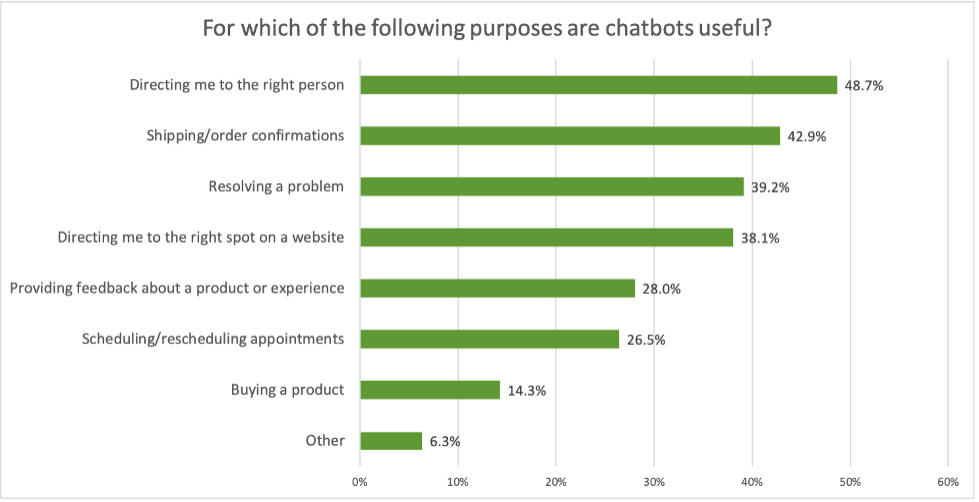This is the last of a three-part series examining how companies are transforming their customer experience strategies through the use of technology. The first article in the series is about the use of all types of AI in the contact center while the second article discusses the potential and current usage of generative AI.
When customer experience (CX) leaders or consumers talk about AI in customer service, chatbots are at the forefront of the discussion. But chatbots aren’t producing the success metrics they should be—at least not yet.
Chatbots and voicebots interact with customers on websites, in self-service channels, over SMS, or on phone calls. Chatbots are software automation programs that may or may not use AI, but nowadays, most companies opt for AI to interpret information, boost productivity, and even make recommendations that drive revenue. Chatbots can respond using decision trees or pre-programmed information (non-AI), or they can leverage machine learning to generate responses that adapt to the situation, content, or requests.
Semantics is an issue with this technology. As AI comes into the picture, some refer to the chatbots as “conversational AI,” where natural language processing, sentiment analysis, and other forms of AI help enable the chatbots to be more intelligent—helping customers solve a problem or complete a task. Virtual assistants are another term used in the context of chatbots. Alexa and Siri are familiar personal virtual assistants, helping with reminders and automating tasks. Virtual assistants in the contact center are sophisticated chatbots that use conversational AI, engage in human-like conversations, and assist both agents and customers.
Use of Chatbots
Companies use chatbots, or their more sophisticated versions, for several purposes. In some cases, they act independently and don’t assist live agents; in others, they do.
Internally, they can confirm agents have read the required statements and are being friendly. They also can provide context to help live agents resolve issues. They can close sales without agent involvement, or they can help the agents close sales through making next-best-action recommendations. They’re also starting to verify customer identity, saving agents time during a live interaction.
Externally, they are gathering feedback from customers after an interaction. They’re also helping customers in self-service channels by guiding them to the right spot on a website, providing product information, or completing warranty claims. They also can triage issues at hand and route to the best live agent.
Impact of Chatbots
CX leaders say that chatbots touch 38.5% of all interactions, and of those, they solve 42.1%. Sounds pretty decent, but doing the math shows that the virtual assistants fully solve only 16 in 100 interactions. Part of the issue is that many companies have tried to “boil the ocean,” so to speak, in years past. They rolled out AI-powered chatbots that were not properly trained and for misaligned purposes.
Now, various companies, including Dialpad, Five9, NICE and Verint, provide purpose-built chatbots that deliver improved results. As more companies become deliberate about how they apply chatbots to purposes, the number of fully solved interactions will increase.
In fact, already, 35.9% of companies have assigned employees to oversee the bot army to get them back on track when they get confused. Another 52.2% of companies are planning for this structure to improve the performance of their bots. (These data points are from Metrigy’s Customer Experience Optimization:2034-24 global study of 641 companies.)
Consumer Perspective
As chatbots improve, we anticipate customers’ perspectives of them to improve, as well. At this point, only 13.3% of consumers said they prefer chatbots, 39.3% avoid them, and 47.4% use them in select circumstances, according to Metrigy’s Customer Experience Consumer Insights 2023-24 research study of 503 consumers. Not exactly a sales pitch for chatbots.
The biggest problems are that chatbots don’t understand consumers and don’t have answers to their problems. In other words, they aren’t properly programmed. Consumers also said they are difficult to use. In other words, they need some user interface work.
Consumers still find value in chatbots in some key areas, as the figure below indicates. For example, they find them useful for directing them to the right person (48.7%) or spot on a website (38.1%), for logistics such as shipping/order confirmations (42.9%) or scheduling/rescheduling appointments (26.5%), and even providing feedback about a product or experience (28%).
Despite the fact that few prefer chatbots today, when asked to describe their most recent chatbot experience, 44% of consumers said it was positive, 28% said it was neither positive or negative, and 24% said it was negative (the rest are unsure or don’t remember).
I’ll take that as an indication that acceptance of chatbots is going to improve, and success metrics will follow.










